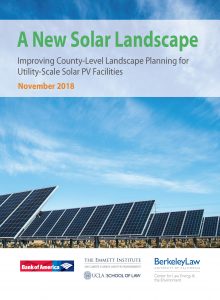 UC Berkeley and UCLA Schools of Law are today releasing a new report, A New Solar Landscape, which identifies key reforms for California to enact at the state, regional, and local level to increase the pace and optimal siting of utility-scale solar photovoltaic (PV) development. With the passage of SB 100 (de León, 2018), California now requires electric utilities to obtain 60 percent of their electricity from renewable sources by 2030 and 100% carbon-free electricity by 2045. To meet these goals, the report recommends that state leaders:
UC Berkeley and UCLA Schools of Law are today releasing a new report, A New Solar Landscape, which identifies key reforms for California to enact at the state, regional, and local level to increase the pace and optimal siting of utility-scale solar photovoltaic (PV) development. With the passage of SB 100 (de León, 2018), California now requires electric utilities to obtain 60 percent of their electricity from renewable sources by 2030 and 100% carbon-free electricity by 2045. To meet these goals, the report recommends that state leaders:
- Encourage development of county-level landscape plans by linking them to incentives like expedited review under the California Environmental Quality Act.
- Ensure that project benefits flow first to communities most immediately affected by development.
- Increase support for transmission infrastructure located in areas appropriate for solar development.
- Create a consolidated, statewide zoning and planning data resource.
The report is sponsored by Bank of America and informed by two expert stakeholder convenings facilitated by the law schools.
Utility-scale solar PV facilities—large panel arrays that generate power to sell into the electrical grid—are the most economical method of delivering the large quantities of power needed to satisfy California’s renewables portfolio standard (RPS). Solar energy is the most significant source of renewable energy in California, accounting for over one-third of all renewable power generated in 2017, and well over half of total generating capacity. As solar prices continue to fall, many experts agree that solar will play an even greater role in California’s achievement of future renewables targets, potentially constituting up to 95 percent of new generation.
But these projects, often located in rural areas, can face significant barriers to obtaining the local approvals necessary to begin development, potentially hindering climate progress. To address issues such as a lack of local buy-in to proposed projects and a lack of coordination among local and state planners, the report proposes policies such as:
- Quantifying the total amount of land needed for solar PV facilities in order to meet the state’s climate goals, and communicating this information to local communities where the facilities might be located;
- Preparing solar PV permitting guidebooks that clarify local requirements for developers and help residents understand the process;
- Increasing coordination between state and utility electrical transmission planners and local governments responsible for project approvals; and
- Encouraging community benefit agreements that guarantee local benefits in connection with new solar PV developments.
These recommendations, among many others described in A New Solar Landscape, can help California’s policymakers, local governments, and solar industry leaders develop a county-level landscape planning system that accounts for and promotes state renewable energy targets, environmental conservation and land preservation goals, and community development needs.
For more details, download the report here.


